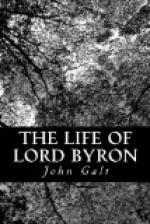On leaving England I began to write a poem in the Spenserian measure. It was called The Unknown, and was intended to describe, in narrating the voyages and adventures of a pilgrim, who had embarked for the Holy Land, the scenes I expected to visit. I was occasionally engaged in this composition during the passage with Lord Byron from Gibraltar to Malta, and he knew what I was about. In stating this, I beg to be distinctly understood, as in no way whatever intending to insinuate that this work had any influence on the composition of Childe Harold’s Pilgrimage, which Lord Byron began to write in Albania; but it must be considered as something extraordinary, that the two works should have been so similar in plan, and in the structure of the verse. His Lordship never saw my attempt that I know of, nor did I his poem until it was printed. It is needless to add, that beyond the plan and verse there was no other similarity between the two works; I wish there had been.
His Lordship has published a poem, called The Curse of Minerva, the subject of which is the vengeance of the goddess on Lord Elgin for the rape of the Parthenon. It has so happened that I wrote at Athens a burlesque poem on nearly the same subject (mine relates to the vengeance of all the gods) which I called The Atheniad; the manuscript was sent to his Lordship in Asia Minor, and returned to me through Mr Hobhouse. His Curse of Minerva, I saw for the first time in 1828, in Galignani’s edition of his works.
In The Giaour, which he published a short time before The Bride of Abydos, he has this passage, descriptive of the anxiety with which the mother of Hassan looks out for the arrival of her son:
The browsing camels’ bells are tinkling—
His mother look’d from her
lattice high;
She saw the dews of eve besprinkling
The parterre green beneath her eye:
She saw the planets faintly twinkling—
’Tis twilight—sure
his train is nigh.
She could not rest in the garden bower,
But gazed through the grate of his steepest tower:
Why comes he not—and his steeds are fleet—
Nor shrink they from the summer heat?
Why sends not the bridegroom his promised gift;
Is his heart more cold or his barb less swift?
His Lordship was well read in the Bible, and the book of Judges, chap. 5, and verse 28, has the following passage:—
“The mother of Sisera looked out at a window, and cried through the lattice, Why is his chariot so long in coming; why tarry the wheels of his chariot?”
It was, indeed, an early trick of his Lordship to filch good things. In the lamentation for Kirke White, in which he compares him to an eagle wounded by an arrow feathered from his own wing, he says,
So the struck eagle, stretch’d upon the plain,
No more through rolling clouds to soar again,
View’d his own feather on the fatal dart
And winged the shaft that quivered in his heart.




